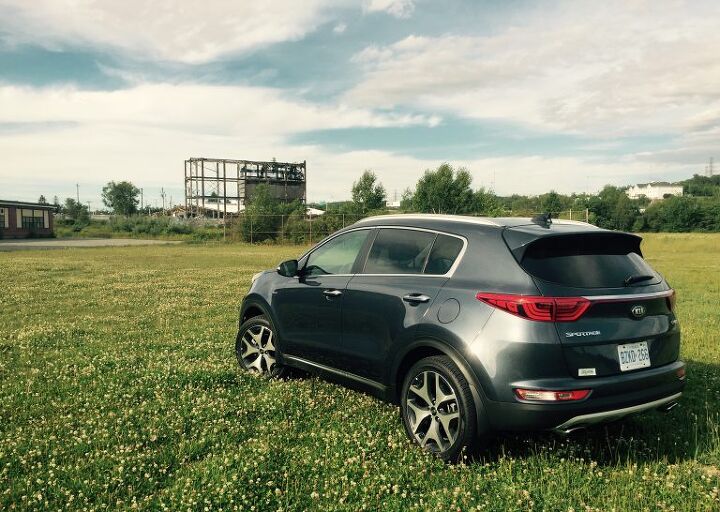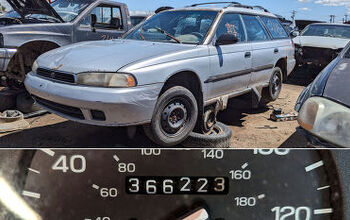This 2017 Kia Sportage SX Was Broken and Slow, Now It's Fixed and Fast
Recognize this Kia?
TTAC’s Matthew Guy drove and reviewed this particular 2017 Sportage SX Turbo in early July. Readers need not an ability to read between the lines to locate Guy’s disappointment in the turbocharged 2.0 liter’s responsiveness, or the nearly complete and total lack thereof.
“Kia’s intent is to offer V6 power with four-banger economy. Unfortunately, I found little of either in this Coke-bottle-sized engine,” he wrote at the time.
The Sportage SX, rated at 237 horsepower and 260 lbs-ft of torque, shuffles its power through all four wheels in a 3,997-pound package. In a 2016 Kia Sorento weighing 4,303 pounds, I said the same powerplant’s mid-range “is as punchy as the Sorento’s available 3.3-liter V6,” and “passing power is plentiful as you ride a 260-lb-ft wave across a plateau of torque.”
Yet in the smaller and lighter Sportage, Matthew says, “Outside Sport Mode, it didn’t even feel like 137 hp, let alone 100 more.” In TTAC’s hyperactive Slack chat at the end of July, he continued, “It drove like cold molasses going backward uphill.”
But Guy was the first auto writer to get seat time in this specific 2017 Kia Sportage SX Turbo. Unbeknownst to him, and to the Kia Sportage’s instrument cluster, the Kia was wounded before getting to the battlefield.
By the time the Sportage reached GCBC Towers in Eastern Passage, Nova Scotia, a month later, a local dealer had fixed it. This Sportage is an entirely different soldier from the one Mr. Guy experienced — and you read about — earlier this summer.
Our fleet manager deemed a visit to the dealer was necessary after two more drivers reported the Sportage as terrifically slow. The official report: “Diagnosed with loose fastener (Clamp) on the turbo intake. Secured fastener – operation normal after repair.”
OXYGEN
In more advanced terms: “If there was a significant leak at the intake on a turbocharged engine, the MAP sensor (assuming that’s what this vehicle has) wouldn’t ‘see’ the boost, and could potentially pull timing to keep from detonating, thus a loss of power,” TTAC’s Chris Tonn told me this morning. TTAC’s Bozi Tatarevic says that an air leak could have caused a fueling condition or boost leak, which could cause the 2.0-liter turbo to “act like it was naturally aspirated.” Not good.
Given that turbos make their living by maximizing the benefits of air, the 2.0-liter turbo four couldn’t, and didn’t, feel like a 2.0-liter turbo four.
Blame Kia, blame workers at the Sportage’s Gwangju plant, blame the O’Regan’s Kia dealer that performed the pre-delivery inspection, blame the raccoon in Guy’s driveway for disconnecting the fastener while Matthew dreamed of a Hemi-powered Cadenza. Blame Obama if you must. But it’s fixed now.
SPEED
Sub-seven-second 0-60 times aren’t common in a class full of sub-190-horsepower crossovers. But the turbocharged Sportage’s 3.4-second launch from 30-50 mph and its 4.7-second 50-70 result are the figures that truly cause the Kia to stand out from the pack.
America’s top-selling utility vehicle four years running, the Honda CR-V, doesn’t have an optional hi-po engine and needs 4.3 and 5.4 seconds, respectively, in those same tests.
2016’s current top-selling SUV/crossover, the Toyota RAV4, needs 4.1 and 5.3 seconds in more powerful hybrid guise.
The 2.0-liter turbo in the Ford Escape, America’s fourth-ranked utility vehicle, with more horsepower and torque, makes the race somewhat closer, with 3.7 and 5.1-second results.
But the Sportage isn’t merely the on-paper test-track winner in comparison with these more popular rivals; these are not meaningless tenths-of-second differences. There’s a liveliness and urgency to the Kia’s proceedings that, to be honest, the overwhelming majority of small crossover consumers are willing to go without.
MONEY
There are other associated costs. The Environmental Protection Agency rates the Escape EcoBoost AWD at 23 mpg combined; the Forester XT at 25 mpg (on premium fuel). The 2017 Kia Sportage SX Turbo AWD has a combined 21-mpg rating. We observed 21.8 mpg over the course of our mostly urban test during a hot week in early August.
Given the turbocharged 2.0 liter’s accompanying SX trim and Kia’s relatively newfound knack for producing genuinely luxurious, high-quality interiors, there are other associated benefits to go along with the hoity toity price tag. The panoramic sunroof, cooled seats, Harmon Kardon audio, and extensive safety gear are neither the stuff of your Kia Spectra dreams nor the content received in exchange for $30,170 in a Subaru showroom.
Meanwhile, the Kia excels in areas aside from its smooth, quiet, and powerful powertrain and its high levels of equipment. The Sportage is now competitively spacious. Perceived quality is high, with a stout structure and pleasant materials, excessive piano black trim aside. After the jarring third gen’s atrocious ride quality, the new Sportage is much more comfortable, though it’s no class leader on 19-inch wheels.
SORENTO
Kia hasn’t turned the Sportage SX Turbo into a veritable sporting SUV with keen turn-in and flat cornering and quick reflexes and snappy shifts. It’s merely a smaller Sorento rival available for a slightly smaller amount of money.
The savings need to be substantial. The 2017 Kia Sportage SX Turbo, especially when it’s truly turbocharged, is a fine piece of kit. The 2017 Kia Sorento EX Turbo nevertheless does everything better and is more than worth the modest monthly payment increase.
[Images: © 2016 Timothy Cain/The Truth About Cars]
Timothy Cain is the founder of GoodCarBadCar.net, which obsesses over the free and frequent publication of U.S. and Canadian auto sales figures. Follow on Twitter @goodcarbadcar and on Facebook.
More by Timothy Cain
Latest Car Reviews
Read moreLatest Product Reviews
Read moreRecent Comments
- 1995 SC The Ridgeline is too new so nothing yet.The FIAT needed a tire (nail in the sidewall) and a lower steering column cover and a set of wipers. Around 200 bucksThe 30 year old Thunderbird has been needy this year. Just did fuel injectors to add to belts, hoses, motor mounts, exhaust manifold gasket, shocks and a bunch of caps replaced on various modules.Rear main has developed a small leak so I will probably have the transmission gone through when I drop it. I want to do a few things to it. I have some upgraded front calipers too but they are junk yard parts I rebuilt. Like I said, it has been needy this year but old cars do that sometimes
- Tane94 Mini annual oil change at dealership, synthetic oil and new filter, $129 but sometimes $99 when a coupon is offered.
- Mike Beranek All that chrome on the dashboard must reflect the sun something fierce. There is so much, and with so many curves, that you would always have glare from somewhere. Quite a contrast to those all-black darkroom interiors from Yurp.
- Mike Beranek 2004 Buick LeSabrepurchased in 2017, 104k, $3,100currently 287knever been jumped never been on a tow truckstruts & shocks, wheel bearings, EGR valves. A couple of O2 sensors, an oil pressure sending unit, and of course the dreaded "coolant elbows". All done in my garage with parts so plentiful there are a dozen choices of everything on Rock Auto.I've taken it to the west coast twice and the east coast once. All-in I'm under 5 grand for over 180,000 reliable miles. Best used-car purchase ever.
- Jalop1991 Our MaintenanceCosts has been a smug know-it-all.





































Comments
Join the conversation
The lack of knowledge about how turbocharged engines work expressed in the article is really sad. If the charge piping is disconnected the turbo is nothing but a restriction in the exhaust and actually causes a reduction in performance versus an equivalent sized NA engine. The air being pushed by the turbo just vents to atmosphere. Anyone with a $10 obd2canbus scanner could figure out what was wrong in 60 seconds by looking at MAP pressure readings. Hmm it never goes past atmospheric pressure you say? Duh the charge piping is disconnected. Cars should be reviewed by people who actually know how they work.
I had the exact opposite experience. the Kia felt like an underengineered, tinny, econobox while the Escape felt solid and well planted.